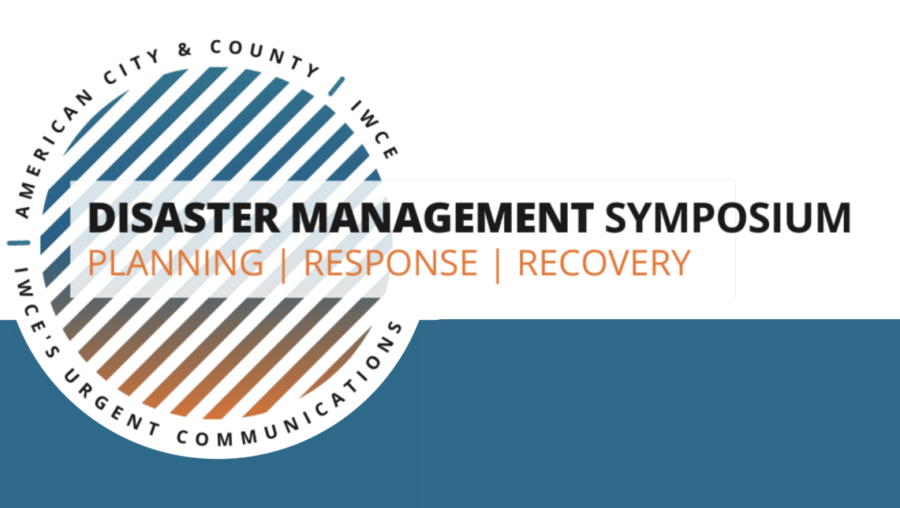Check out key takeaways from Disaster Management Symposium webinars, register to view archives
The inaugural Disaster Management Symposium was conducted Nov. 8, when consecutive hour-long webinars featured expert panelists exploring various aspects of the three main phases of a disaster for public safety and governments: planning, response and recovery.
This virtual symposium was a joint effort of IWCE’s Urgent Communications, IWCE and American City & County.
If you attended the Disaster Management Symposium live and would like to revisit a session or listen to one you may have missed, check your e-mail for a link to archived recordings. For those who missed the live event entirely but would like to listen to the recorded webinars, visit the registration page at https://informatech.tradepub.com/free/w_defa5134/ to access the archived sessions.
To help you decide which sessions may be most applicable to you, below is a brief description of each session and some key takeaways from the sessions.
Session 1
Disaster Planning—Preparing for the Worst
When disaster threatens, people turn to their local governments and utilities for assurance, guidance, and safety. Our panelists discussed internal preparation efforts, as well as best practices for fostering community connections and ensuring that citizens know what to do, where to go, and who to contact in a worst-case scenario.
Speakers on the panel were Ryan Ackerman, administrator of the Souris River Joint Board; Michelle Geddes, chief information officer for San Francisco’s Department of Emergency Management; Pat Hart, senior director of resilience for the American Public Power Association; and Jason Harris, CTO of ROK Technologies, which sponsored the session.
Some key takeaways from the session included:
- Ackerman, a water resources manager who is working on a comprehensive engineering resilience project in the Minot region of North Dakota, highlighted the importance of tracking data in-house. If they had their own risk-assessment matrix when the flood happened in 2011 instead of relying on federally tracked flow data, the outcome would have been different.
- Hart stressed unity of message and unity of effort when planning. “We have these battle-tested plans for restoring power quickly and safely,” he said. “It used to be that our mutual-aid networks were more regional and based on personal relationships. But we now have a … very intricate system in place that allows us to pull crews from multiple regions.”
- Geddes talked about implementing redundancy in telecommunications technologies—for example, by using multiple carriers, like FirstNet and Verizon Frontline—so if one system goes down, there’s another communication route available. She also talked about the importance of internet-based alerting systems and fostering partnerships with broadcasters. “It’s really about diversity, and having multiple modes of communication,” she said.
- When disaster happens, the influx of new connections and requests can overload digital systems. Harris talked about the need for organizations to scale GIS systems appropriately as circumstances in the field evolve. While hardwired systems do allow this, the cloud provides an economical and practical solution for organizations of all sizes.
Session 2
Disaster Response: Taking action to keep the lines of communication open
During this session, our panel of experts discussed the types of communications necessary to enable efficient responses, from alerting the public to directing the personnel trained to address the myriad issues associated with the disaster.
Speakers on the panel were Dan Munsey, fire chief of San Bernardino County (Calif.); Red Grasso, director of the First Responder Emerging Technologies (FirstTech) program for the State of North Carolina; and Ben Holycross, retired radio systems manager for Polk County, Fla.
Some key takeaways from the session included:
- Areas hit by a disaster certainly are in need of help from entities coming from outside the impacted locations, but Holycross emphasized that responding units should prepare to be self-sufficient, because the disaster area will be significantly lower on resources—if they have them at all. Not only does this apply to mission-focused capabilities, but also the realities of day-to-day life. “The question is not who brought the toilet paper, but who brought the toilet?” he said.
- Munsey noted that new technologies are playing increasingly important roles in response efforts, particularly in the ability to model the direction and spread of wildfires or storms. And this information can be shared with those in the field much more easily and reliably than even a decade ago, as the evolution of satellite technologies make it simpler to move and deploy, while providing options for greater data throughput and lower latencies.
- Grasso echoed both of these points, providing the perspective of someone that has helped coordinate response efforts from a state emergency operations center (EOC). Grasso and Munsey also cited some of the challenges associated with sharing accurate information with the public in a social-media-driven world that can be fraught with misinformation and rumors in the aftermath of a disaster.
Session 3
Disaster Recovery: Priorities in Disaster Relief
Every region facing a disaster faces a unique recovery process. This session looked at recovery from debris removal to getting aid from the Federal government to make communities whole again.
Expert insights were provided by Sgt. Robert Dooley, Unmanned Vehicle Program, Florida Highway Patrol; Jared Jones, assistant city manager, Panama City, Fla.; and Grady Joseph, disaster recovery lead for the Western Fire Chief’s Association.
Some key takeaways from the session included:
- Technology: Using drones has become imperative in disaster recovery, from providing information from locations that people cannot safely navigate to providing critical before-and-after maps of devastated areas—maps that help inform recovery strategies, as well as funding from state and federal sources. Sgt. Robert Dooley explained how drone technology is being used to save money and manpower.
- Long-term implications: Recovery continues long after the TV camera are gone, sometimes taking months or even years to clean up and rebuild. Grady Joseph addressed how communities can best plan for extended recovery, and how preparation is the first step of recovery.
- Recovery isn’t just clean up and done: Jared Jones explained that one disaster can lead to different issues—for example, hurricanes that rip out trees can lead to future flooding or wildfires following the path of the original storm.
As a reminder, those who attended the Disaster Management Symposium live and would like to revisit a session or listen to one they missed can check their e-mail for a link to archived recordings. For those who missed the live event entirely but would like to listen to the recorded webinars, visit the registration page at https://informatech.tradepub.com/free/w_defa5134/ to access the archived sessions.

















